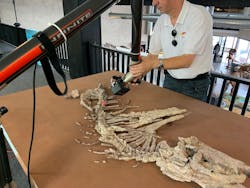Manufacturers are spending millions of dollars to implement smart systems that include machine learning, sensors, and robotics to jump on the Industry 4.0 bandwagon. The white papers and news articles all make sense. Technology is available — and increasingly affordable — to enable even small and medium-size manufacturers to reap benefits previously reserved for massive corporations with deep pockets.
But before businesses sign off on investments in technology, it’s important that they step back and leverage their most important asset: human strategy. Otherwise, those not-inconsequential investments in technology might go to waste.
Ask Yourself: Who Are You?
The first step in becoming a smart manufacturer is defining what your company does in a more accurate way that can change how you think about product design, marketing, and sales.
For example, last year, California Manufacturing Technology Consulting (CMTC) met with a printer who wanted our help evaluating their current operational plan, manufacturing process, and supply chain, so that they could better understand their work and how they could grow. When I asked the owner what her business was, she pointed to the presses on the plant floor and said, “The printing business.”
But that answer was only partially true. It didn’t engage with a fundamental question key to defining any business: Why are you doing what you are doing? Once I posed this question to the owner, she quickly realized that she was truly in the business of creating experiences that inspire individuals with a sense of fun and adventure.
Her clients included escape rooms, shopping malls, and sports arenas for the Los Angeles Kings, Clippers, and Lakers, for which she has manufactured stadium banners that are integral to those teams’ fans’ experiences. So yes, while her company prints things, their inspirational effects are so much more.
Changing the conversation about how the business owner defined her business transformed the way she could think about her manufacturing, distribution, installation, and post-installation processes. With this new perspective in place, her team started to think about the intention behind every product and how best to realize it, what print quality best applied to each product, and how materials could be laid out to draw end users’ attention to the aspects that would most engage them. We began to analyze data not just to manage her supply chain and the best use of her machines, but to start to answer questions that would allow her company to deliver the best customer experience.
Establish Goals and a Roadmap
Once a business is clearly defined, goals can be established and a roadmap can be created to achieve those goals — and it’s important to emphasize that this is not a technology roadmap; it’s a business roadmap.
Technology is just an enabler for solving problems across the board. Market, product, operational technology, processes, and people are all considered during roadmap development. How do all these segments align with your go-to-market strategy? That’s the question at the center of any smart manufacturing journey, so companies can know exactly why and how a technology investment is being made to further their goals.
To make goals tangible for individuals, a subset of the overarching goals must be established for every worker. Technology can then be used to cascade relevant information across the company and make smart workers. For instance, when something happens on the plant floor, a dashboard may pop up that provides an analysis of what’s happening, diagnose the problem, and provide options for resolving it. By providing workers with actionable information, workers can make better decisions.
Rally Around a Common Goal
Implementing change is hard. In a room of department heads, there can be a misalignment of executives; a lack of understanding of each other’s functions; or even a basic resistance to change.
If I’m bringing together a person whose job it is to make a product and a person whose job is to sell the product, there is a tremendous amount of tension. The engineer considers the product their baby — they want it to be perfect. Meanwhile, the salesperson is focused on getting that product to customers on time. How do you honor the creative emotion of the engineer, while still meeting the market goals of the salesperson?
People in operations, marketing, sales, or any other department may disagree on a hundred things, but they’ll usually agree that the business must grow. So if you start from that common place, you can slowly build a whole that supports everyone’s efforts.
If your company is planning to invest in smart manufacturing technology, make sure to contact your local MEP Center before you commit to anything. You’ll be surprised at how much more effective smart manufacturing can be when backed by a strategic approach.
Shekhar Chandrashekhar
Shekhar Chandrashekhar is the Smart Manufacturing Practice Lead for California Manufacturing Technology Consulting (CMTC), part of the MEP National NetworkTM. He leads clients in crafting strategies and integrating the right end-to-end technology to get the right information at the right time in the right form to the right people throughout the value chain to enable smart decisions.

